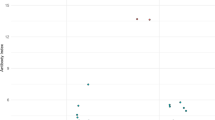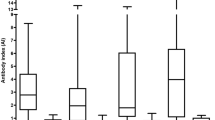Abstract
In clinical cases suspected for viral encephalitis or meningoencephalitis, the estimation of virus-specific antibodies especially in liquor requires high sensitivity as well as specificity. With enzyme immunoassays the sensitivity in detecting antibodies has increased compared to e.g., complement fixation tests. This report concerns the determination of virus-specific antibodies with a commercial enzyme-linked immunosorbent assay (ELISA) in paired liquor/serum samples of four patients with encephalitis or meningoencephalitis. Up to six virus-specific antibodies of the IgG and IgM classes have been determined [herpes simplex virus (HSV), varicella-zoster virus (VZV), cytomegalo virus, mumps virus, measles virus, and rubella virus]. Additionally, serum samples from several patients suffering, or recovered from, diseases caused by HSV and VZV without CNS involvement have been included as controls. The results showed that besides the virus-specific antibody development (IgG and IgM) against the leading virus, i.e., principally concerned in the disease manifestation assumed to be primarily causing the disease, virus-specific antibodies of the IgG and IgM class against a heterologous virus (e.g., VZV) could also be measured with substantial titers. “Cross-reacting” antibodies to both HSV and VZV with the ELISA only appeared and were present in cases where the infection mainly affected the CNS: no such immunological “cross-reactivity” was observed in serum of individuals in “clinically silent” stages of both HSV and VZV infections. The same situation with no measurable “cross-reacting” antibodies was found in cases of acute HSV or VZV diseases where the CNS was not involved. These findings have been discussed with respect to the findings of common antigens, especially between HSV and VZV, and with respect to an unspecific stimulation of immunocompetent cells.
Similar content being viewed by others
Abbreviations
- CSF:
-
Cerebrospinal fluid
- ELISA:
-
enzyme-linked immunosorbent assay
- CF-test:
-
complement fixation test
- NT:
-
neutralization test
- IFT:
-
immunofluorescence test
- vIgG:
-
virus-specific IgG-antibody
- vIgM:
-
virus-specific IgM-antibody
- HSV:
-
herpes simplex virus
- VZV:
-
varicella zoster virus
- EEG:
-
electro-encephalogram
- CCT:
-
cranial computer tomogram MEM, minim essential medium
References
Ahmed R, Oldstone MBA (1984) Mechanisms and biological implications of virus-induced polyclonal B cell activation. In: Notkins AL, Oldstone MBA (eds). Springer, Heidelberg, pp 231–238
Bernstein DI, Frenkel LM, Bryson YJ, Myers MG (1987) Antibody response to herpes simplex virus glycoproteins gB and gD. VIIth International Congress of Virology, Abstract No. R14.20 August 9–14, Edmonton, Canada
Blythe V, Hill TJ (1984) Establishment, maintenance and control of herpes simplex virus (HSV) latency. In: Rouse BT, Lopez C (eds) The immunobiology of herpes simplex virus infection. CRC Press, Boca Raton, pp 9–32
Dennin RH, Knetsch E (1984) The presence of antibody titers in liquor against representative viruses important in human CNS diseases estimated by enzyme immuno assay. 6th International Congress of Virology, September 1–7, Sendai, Japan. Abstract No. P33-25
Dix RD, Lukes S, Pulliam L, Baringer JR (1983) DNA-restriction enzyme analysis of virus from the CBF and brain biopsy tissue in a patient with herpes simplex encephalitis. N Engl J Med 308:1424
Dommasch D, Mertens HG (1980) Cerebrospinalflüssigkeit (CSF). Thieme, Stuttgart, pp 20–26
Edson CM, Hosler BA, Respess RA, Waters DJ, Thorley-Lawson (1985) Cross-reactivity between herpes simplex virus glycoprotein B and a 63,000-dalton varicella-zoster envelope glycoprotein. J Virol 56:333–336
Felgenhauer K, Schliep G, Rapic N (1976) Evaluation of the blood-CSF barrier by protein gradients and the humoral immune response within the central nervous system. J Neurol Sci 30:113–128
Fraser NW, Lawrence WC, Wroblewska Z, Gilden DH, Koprowski H (1981) Herpes simplex type 1 DNA in human brain tissue. Proc Natl Acad Sci USA 78:6461–6465
Frydé A, Link H, Norrby E (1978) Cerebrospinal fluid and serum immunoglobulins and antibody titers in mumps meningitis and aseptic meningitis of other etiology. Infect Immun 21:852–861
Gilden DH, Vafi A, Shtram Y, Becker Y, Devlin M, Wellish M (1983) Varicella-zoster virus DNA in human sensory ganglia. Nature 306:478–480
Hammer SM, Buchman TG, d'Angelo LJD, Karchmer AW, Roizman B, Hirsch MS (1980) Temporal cluster of herpes simplex virus encephalitis: investigation by restriction endonuclease cleavage of viral DNA. J Infect Dis 141:436–440
Harford CG, Wellinghoff W, Weinstein RA (1975) Isolation of herpes simplex virus from cerebrospinal fluid in viral meningitis. Neurology 25:198–200
Hyman RW, Echer JR, Tenser RB (1983) Varicella-zoster virus RNA in human trigeminal ganglia. Lancet II: 814–816
Johnson RT (1982) Viral infections of the nervous system. Raven Press, New York, pp 169–200
Nahmias AJ, Whitley RJ, Visitine AN, Takei Y, Alford jr CA (1982) Herpes simplex virus encephalitis: laboratory evaluations and their dignostic significance. J Infect Dis 145:829–836
Nitamura K, Namazue J, Campo-Vera H, Ogino T, Yamanishi K (1986) Induction of neutralizing antibody against varicella-zoster virus (VZV) by VZV gp3 and cross-reactivity between VZV gp3 and herpes simplex viruses gB. Virology 149:74–82
Rock DL, Nesburn AB, Ghiasi H, Ong J, Lewis TL, Lokensgard JR, Wechsler SL (1987) Detection of latency-related viral RNAs in trigeminal ganglia of rabbits latently infected with herpes simplex virus type 1. J Virol 61:3820–3826
Ross CAC, Sharpe JH, Ferry P (1965) Antigenetic relationship of varizella-zoster and herpes simplex. Lancet II:708–711
Schaap GJP, Huisman J (1968) Simultaneous rise in complement fixing antibodies against herpes simplex viurs and varicella-zoster virus in patients with chickenpox and shingles. Arch gesamte Virusforsch 25:52–57
Schmidt N (1982) Further evidence for common antigens in herpes simplex and varicella-zoster virus. J Med Virol 9:27–36
Schmidt JN, Lennette EH, Magoffin RL (1969) Immunological relationship between herpes simplex virus and varicella-zoster virus demonstrated by complement fixation, neutralization and fluorescence antibody test. J Gen Virol 4:321–328
Scheid W (1980) Lehrbuch der Neurologie. G Thieme, Stuttgart, pp 561–562
Sequiera LW, Carrasco LH, Curry A, Jennings LC, Lord MA, Sutton RNP (1979) Detection of herpes simplex virus genome in brain tissue. Lancet I:609–612
Shibuta H, Ishikawa T, Hondo R, Aoyama Y, Kurata K, Matumoto M (1974) Varicella-zoster virus isolation from spinal ganglion. Arch gesamte Virusforsch 45:382–385
Svedmyr A (1964) Varicella-zoster virus in HeLa cells. Arch gesamte Virusforsch 17:495–503
Vandvik B, Norrby E, Steen-Johnsen J, Stensvold K (1978) Mumps meningitis: prolonged pleocytosis and occurrence of mumps virus-specific oligoclonal IgG in the cerebrospinal fluid. Eur Neurol 17:13–22
Vandvik B, Vartdal F, Norrby E (1982) Herpes simplex virus encephalitis: intrathecal synthesis of oligoclonal virus specific IgG, IgA and IgM antibodies. J Neurol 228:25–38
Vandvik B, Sköldenberg B, Forsgren M, Stiernstedt G, Jeansson S, Norrby E (1985) Long-term persistence of intrathecal virus-specific antibody responses after herpes simplex virus encephalitis. J Neurol 231:307–312
Vartdal F, Vandvik B, Norrby E (1982) Intrathecal synthesis of virus-specific oligoclonal IgG, IgA and IgM antiboedies in a case of varicella-zoster meningoencephalitis. J Neurol Sci 57:121–132
Warren KG, Marusky RG, Lewis ME, Jeffrea VM (1982) Recovery of latent herpes simplex virus from human trigeminal nerve roots. Arch Virol 73:85–89
Wechsler SL, Nesburn AB, Zwaagstra J, Ghiasi H (1989) Sequences of latency-related gene of herpes simplex virus type 1. Virology 168:168–172
Whitley R, Lakeman AD, Nahmias A, Roizman B (1982) DNA restriction-enzyme analysis of herpes simplex viurs isolates obtained from patients with encephalitis. N Engl J Med 307:1060–1062
Wolf MH, Büchel F, Zoll A (1979) Serological studies on the antigenetic relationship between herpes simplex virus and varicella-zoster virus. Immunbiology 156:76–82
Wolinsky JS, Johnson RT (1980) Role of viruses in chronic neurological diseases. In: Fraenkel-Conrat R, Wagner R (eds) Comprehensive virology. Plenum Press, New York, pp 257–296
Wutzler P, Färber I, Ulbricht A (1978) Autoantibodies in herpes virus infections. Acta virol 22:342–344
Author information
Authors and Affiliations
Rights and permissions
About this article
Cite this article
Dennin, R.H., Herb, E. Immunological diagnosis in viral infections of the central nervous system: course of antibody titres against homo- and heterologous viruses. Med Microbiol Immunol 178, 255–268 (1989). https://doi.org/10.1007/BF00191060
Received:
Issue Date:
DOI: https://doi.org/10.1007/BF00191060




